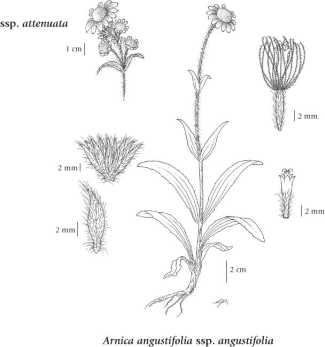Arnica angustifolia Vahl subsp. angustifolia
narrow-leaf arnica (alpine arnica; narrowleaf arnica)
Asteraceae (Aster family)
Introduction to Vascular Plants
narrow-leaf arnica (alpine arnica; narrowleaf arnica)
Asteraceae (Aster family)
Introduction to Vascular Plants
Map
Distribution of Arnica angustifolia subsp. angustifolia
Click here to view the full interactive map and legend
Species Information
General:
Perennial herb, from an ascending, fibrous-rooted rhizome or stem-base; stems leafy, erect or sometimes ascending, simple or branched only in the inflorescence, sparsely to densely hairy or sometimes glandular at least in the upper portion, 10-50 cm tall.
Leaves:
Basal leaves lance-shaped to narrowly elliptic, hairy and often glandular, stalked, entire to toothed; stem leaves opposite, 2-4 pairs (rarely 1 or 5), reduced and becoming unstalked and entire upwards.
Flowers:
Heads with ray and disk flowers, solitary to 5 (rarely 7), the bases densely white-hairy; involucres 10-18 mm tall; involucral bracts lance-shaped, hairy, and usually glandular; ray flowers yellow, 10-16, toothed at the apex; disk flowers yellow.
Fruits:
Achenes 4-8 mm long, uniformly densely hairy and often glandular; pappus white, finely-barbed.
Notes:
Two subspecies occur in BC.
1. Plants and involucres conspicuously white, woolly long-hairy; stems 5-20 cm tall, common in the alpine zone throughout BC east of the Coast-Cascade Mountains......................... ssp. tomentosa (Macoun) G. W. Dougl. & G. Ruyle-Dougl.
1. Plants and involucres never conspicuously white, woolly long-hairy; stems 10-25 (rarely 30) cm tall frequent in N and E BC...................... ssp. angustifolia
(Note modified from the original)
Illustration

If more than one illustration is available for a species (e.g., separate illustrations were provided for two subspecies) then links to the separate images will be provided below. Note that individual subspecies or varietal illustrations are not always available.
Illustration Source: The Illustrated Flora of British Columbia
Ecology
Ecological Framework for Arnica angustifolia ssp. angustifolia
The table below shows the species-specific information calculated from
original data (BEC database) provided by the BC Ministry of Forests and Range.
(Updated August, 2013)
The table below shows the species-specific information calculated from
original data (BEC database) provided by the BC Ministry of Forests and Range.
(Updated August, 2013)
| Site Information |
Value / Class |
||
|
Avg |
Min |
Max |
|
| Elevation
(metres) |
1945 | 57 | 2608 |
| Slope
Gradient (%) |
27 | 3 | 80 |
|
Aspect (degrees) |
193 | 20 | 350 |
| Soil
Moisture Regime (SMR) [0 - very xeric; 4 - mesic; 8 - hydric] |
2 | 0 | 4 |
| Modal
Nutrient Regime
Class |
B | ||
| #
of field plots species was recorded in: |
34 | ||
| Modal
BEC Zone Class |
ESSF | ||
|
All BEC Zones (# of stations/zone) species was recorded in |
AT(5), BAFA(9), ESSF(12), IMA(2), SWB(2) | ||
|
Source:
Klinkenberg 2013
|
|||
Habitat and Range
Mesic to dry sites from the montane to alpine zones; common in BC east of the Coast-Cascade Mountains (see key below); circumboreal, N to AK and YT, E to NF and S to MN, SD and WA; Eurasia.Synonyms
Synonyms and Alternate Names:
Arnica alpina
Arnica alpina subsp. angustifolia (Vahl) Maguire
Arnica alpina subsp. attenuata (Greene) Maguire
Arnica alpina subsp. sornborgeri (Fernald) Maguire
Arnica alpina var. angustifolia (Vahl) Fernald
Arnica alpina var. attenuata (Greene) Ediger & T.M. Barkley
Arnica alpina var. linearis Hultén
Arnica alpina var. plantaginea (Pursh) Ediger & T.M. Barkley
Arnica alpina var. ungavensis B. Boivin
Arnica alpina var. vestita Hultén
Arnica angustifolia subsp. attenuata (Greene) G.W. Douglas
Arnica attenuata
Arnica plantaginea Pursh
Arnica sornborgeri Fernald
Arnica terrae-novae Fernald